
A synagogue, also called a shul or a temple, is a place of worship for Jews and Samaritans. It has a place for prayer where Jews attend religious services or special ceremonies such as weddings, bar and bat mitzvahs, choir performances, and children's plays. They also have rooms for study, social halls, administrative and charitable offices, classrooms for religious and Hebrew studies, and many places to sit and congregate. They often display commemorative, historic, or modern artwork alongside items of Jewish historical significance or history about the synagogue itself.

Spitalfields is an area in London, England and is located in the London Borough of Tower Hamlets. It is in East London and situated in the East End. Spitalfields is formed around Commercial Street and Brick Lane. It has several markets, including Spitalfields Market, the historic Old Spitalfields Market, Brick Lane Market and Petticoat Lane Market. The area has a long attracted migrants from overseas, including many Jews, whose presence gained the area the 19th century nickname of Little Jerusalem.

Synagogue architecture often follows styles in vogue at the place and time of construction. There is no set blueprint for synagogues and the architectural shapes and interior designs of synagogues vary greatly. According to tradition, the Shekhinah or divine presence can be found wherever there is a minyan, a quorum, of ten. A synagogue always contains an Torah ark where the Torah scrolls are kept, called the aron qodesh by Ashkenazi Jews and the hekhal by Sephardic Jews.

Bevis Marks Synagogue, officially Qahal Kadosh Sha'ar ha-Shamayim, is an Orthodox Jewish congregation and synagogue, located off Bevis Marks, Aldgate, in the City of London, England, in the United Kingdom. The congregation is affiliated to London's historic Spanish and Portuguese Jewish community and worships in the Sephardic rite.

The West London Synagogue, abbreviated WLS, and fully the West London Synagogue of British Jews is a Reform Jewish congregation and synagogue, located near Marble Arch, at 34 Upper Berkeley Street, in the City of Westminster, in Central London, England, in the United Kingdom.
Chuts is the name applied to Jews who immigrated to London from the Netherlands in the mid-Victorian era (1850s–1860s). They typically came from the cities of Amsterdam and Rotterdam, and brought to London their trades: most notably those of cigar-, cap-, and slipper-making, and as small-time ship chandlers.

The First Roumanian-American Congregation, also known as Congregation Shaarey Shomayim, or the Roumanishe Shul, was an Orthodox Jewish congregation at 89–93 Rivington Street on the Lower East Side of Manhattan in New York City. The congregation was organized in 1885 by Romanian-Jewish immigrants, serving the Lower East Side's large Romanian-Jewish community. The Rivington Street building, erected around 1860, switched between being a church and a synagogue and was extensively remodeled in 1889. The First Roumanian-American congregation purchased it in 1902 and again remodeled it.

The Machzike Hadath, also known as the Spitalfields Great Synagogue, is an Orthodox Jewish congregation and synagogue, located on Highfield Road, Golders Green, in the Borough of Barnet, in the East End of London, England, in the United Kingdom. The congregation was formed predominately by Lithuanian Jews in 1891 and was initially located on Brick Lane. The congregation worships in the Ashkenazi rite.

The Museum of Immigration and Diversity is a museum at 19 Princelet Street in Spitalfields, in the London Borough of Tower Hamlets, England. The Grade II* listed building in which the museum is located was a house built in 1719 for the Huguenot silk merchant Peter Abraham Ogier.
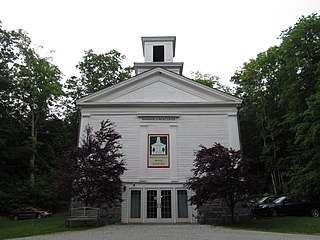
The Montville Baptist Church, now known as the Sandisfield Arts Center, is an historic former Baptist church and Orthodox Jewish synagogue at 5 Hammertown Road in Sandisfield, Massachusetts. The Greek Revival building was constructed in 1839 as a Baptist church. After 83 years as a Baptist church meeting house, the building was converted into use as an Orthodox synagogue for 75 years. In 1995 the Sandisfield Arts Center formed as a non-profit to preserve the building. The building was added to the National Register of Historic Places in 2006.

The Włodawa Synagogue in Włodawa, Poland is an architectural complex consisting of two historic synagogues and a Jewish administrative building, now preserved as a museum. The complex includes the Włodawa Great Synagogue of 1764–74, the late 18th century Small Synagogue, and the 1928 community building. It is "one of the best-preserved" synagogues in Poland.

Brick Lane Mosque or Brick Lane Jamme Masjid, formerly known as the London Jamme Masjid, is a Muslim place of worship in Central London and is in the East End of London.

The Sunderland Synagogue is a former Orthodox Jewish congregation and synagogue, located on Ryhope Road, in Sunderland, Tyne and Wear, England, in the United Kingdom. The congregation was formed as the Sunderland Hebrew Congregation in 1861 and worshiped in the Ashkenazi rite until the congregation was dissolved in 2006.
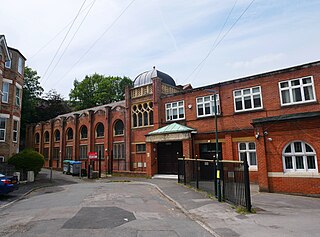
The Bournemouth Community Hebrew Congregation is an Orthodox Jewish congregation and synagogue, located in Wootton Gardens, Lansdowne, Bournemouth, Dorset, England, in the United Kingdom. The congregation was formed in 1905 and worships in the Ashkenazi rite. The rabbi of the congregation is Adrian Jesner.
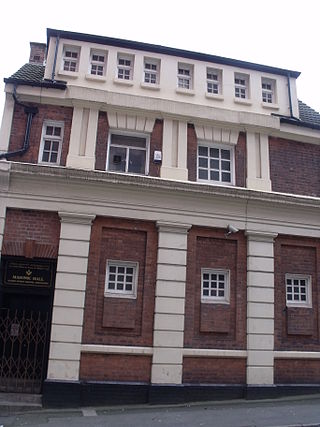
The Severn Street Synagogue is a former Orthodox Jewish congregation and synagogue, located at 60 Severn Street, Birmingham, West Midlands, England, in the United Kingdom. The congregation was founded in 1809 and worshiped in the Ashkenazi rite until the congregation was merged into the Singers Hill Synagogue congregation in 1856.

The Plymouth Synagogue is a synagogue in the city of Plymouth, England and the home of the Plymouth Hebrew Congregation. Built in 1762, it is a listed Grade II* building and the oldest extant synagogue built by Ashkenazi Jews in the English speaking world.

The Shanghai Jewish Refugees Museum is a museum commemorating the Jewish refugees who lived in Shanghai during World War II after fleeing Europe to escape the Holocaust. It is located at the former Ohel Moshe or Moishe Synagogue, in the Tilanqiao Historic Area of Hongkou district, Shanghai, China. The museum features documents, photographs, films, and personal items documenting the lives of some of the more than 20,000 Jewish residents of the Restricted Sector for Stateless Refugees, better known as the Shanghai Ghetto, during the Japanese occupation of Shanghai.
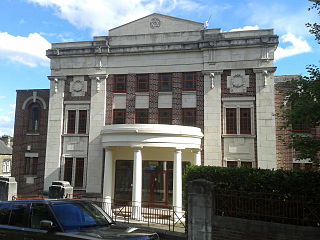
The Wilson Road Synagogue is a former Orthodox Jewish congregation and synagogue, located at 11 Wilson Road, Ecclesall, Sheffield, England, in the United Kingdom. The congregation was formed in 1914 and worshiped in the Ashkenazi rite until the congregation was dissolved in 1997.
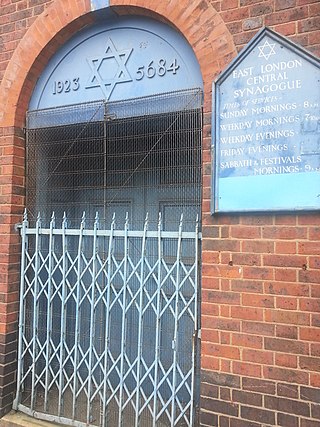
The East London Central Synagogue is an Orthodox Jewish congregation synagogue, located on Nelson Street in the East End of the City of London, England, in the United Kingdom. When founded in 1923, its name was the Nelson Street Sfardish Synagogue. It has "an unassuming exterior and a stunningly beautiful interior". The congregation worships in the Ashkenazi rite.
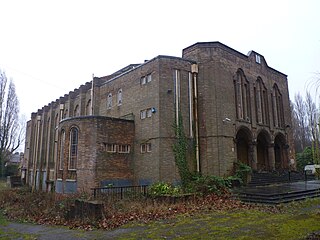
Greenbank Drive Synagogue, officially the Liverpool New Hebrew Congregation, is a former Orthodox Jewish congregation and synagogue that was located on Greenbank Drive, in the Sefton Park area of Liverpool, England, in the United Kingdom. The congregation, formed through a merger of two congregations that date from 1838, worshiped in the Ashkenazi rite.




















